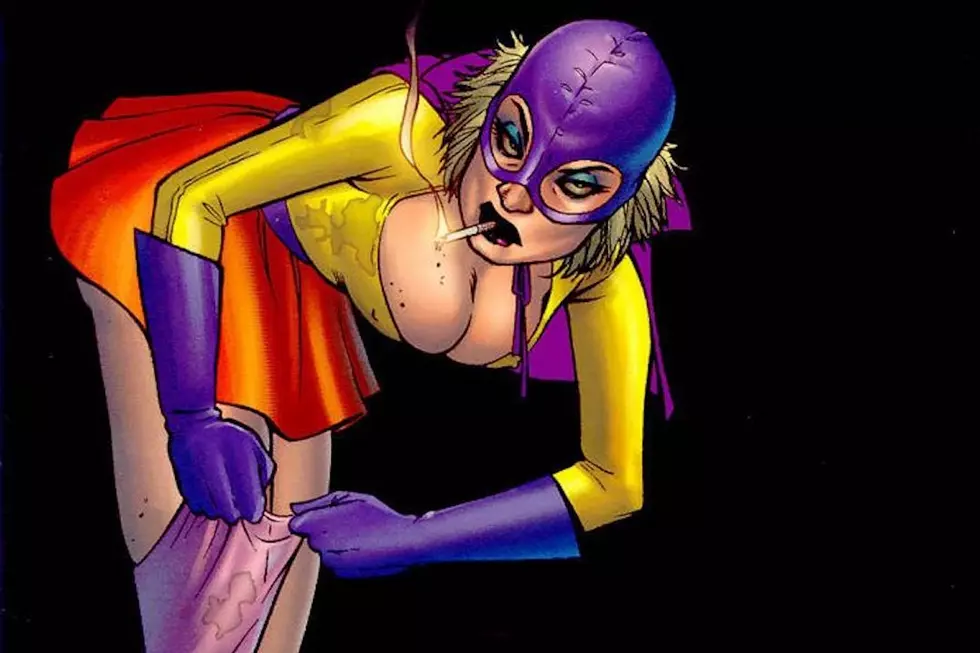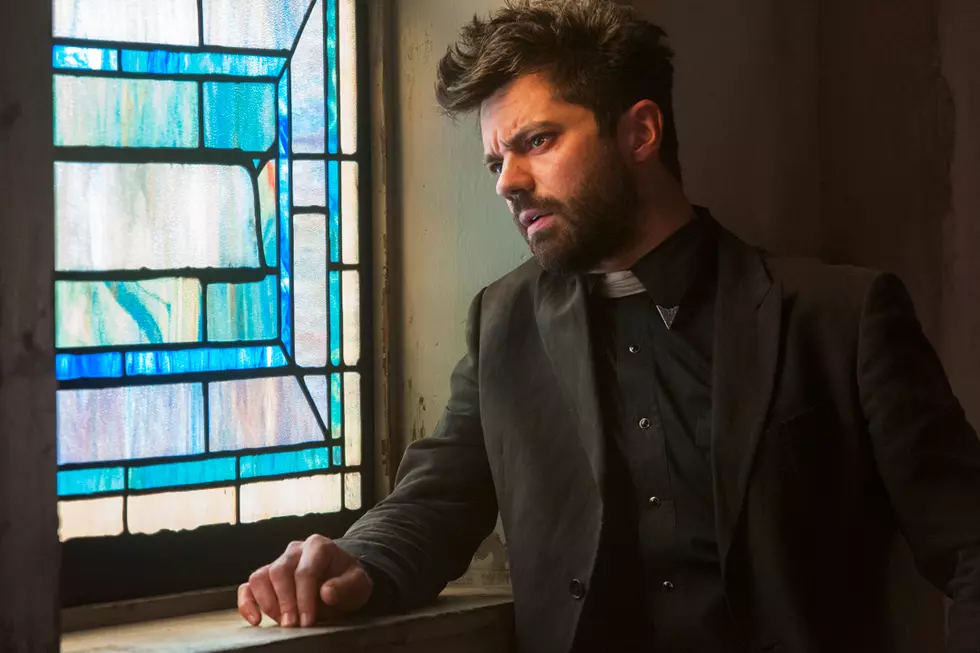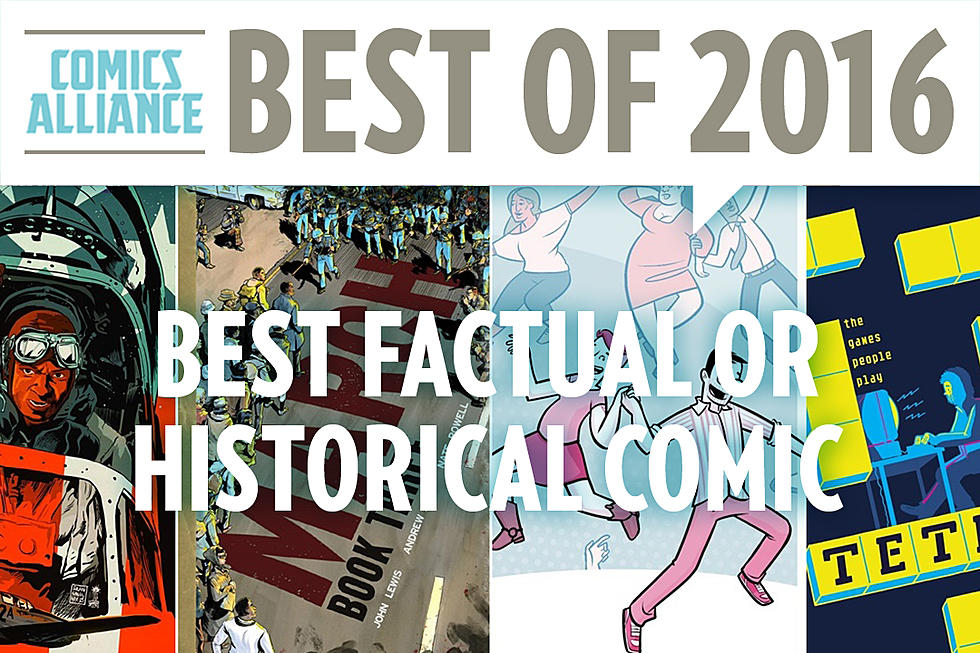
Preacher Ma’am: How Does ‘Ancient History’ Hold Up Today?
As someone who thought she was a dude in the late 1990s, Preacher was the comic I looked forward to every month more than any other. As someone who knows she isn’t a dude in the mid-2010s, I’m looking back on this series and examining what still works, what doesn’t work, and what its lasting legacy is.
This week, it's a break from the regular series as writer Garth Ennis and editor Julie Rottenberg assemble a series of one-shots set in the Preacher expanded universe. What will different artistic styles bring to the table, and what can the tone of each one --- from frivolous to a serious as a tombstone --- tell us about how well fiction ages?
Comedy is hard for a lot of reasons, but one of the main ones is that it is doomed to age poorly. Even humor not trying to be topical, like any given episode of Seinfeld about the quiet inanity of modern life, becomes topical the moment anything unforeseen comes along, such as the invention of the smartphone. Times change; what we’re worried about changes; what’s considered off-limits shifts back and forth. So I always have at least a little respect for the trade in comedy, knowing it’s doomed to be looked back on with a “well, you have to understand, at the time…” qualification.
Preacher is a comedy --- as much as it wrestles with faith, and true love, and machismo turned toxic, and the myth of America, much of the appeal of the series is watching Steve Dillon’s figures talking, acting, reacting and meeting their bloody end, and reading Ennis invent insults and put-downs that would stop a train cold. When people talk about how it ages poorly, they’re talking in part about the comedy, and the collection of stories in Ancient History showcase this very well --- along with how much of a comic’s feel, right down to its comedic sensibilities, is shaped by the artist, even when it’s not obvious.
The least of these efforts, The Good Ol’ Boys, with Carlos Ezquerra on art, Nathan Eyring on color and separations, and Clem Robbins on lettering, is still okay – Ezquerra, the legendary co-creator of Judge Dredd, is never anything less than bad, rending a world where instead of Dillon’s hard and mean figures of pure muscle, everyone seems rendered out of mush and silly putty, ready to be deformed by a solid punch, a knife to the throat, or having their heads pulled off.
But, well: it’s a story where Jody & T.C. are the heroes, and to showcase Jody in a capacity other than the single scariest foe Jesse Custer ever fought feels like it diminishes him as a character. The idea of Jody having a life outside of floating a few steps behind Jesse, smiling with quiet menace, feels out of place.
Moreover, the plot is, in Ennis’ own words, “taking the piss out of the Great American Action Movie,” and while action movies can be incredibly dumb --- exceeded only by the superhero genre, really --- the action movies being skewered in The Good Ol’ Boys just make me feel old. There’s literally a direct reference to the Cindy Crawford/William Baldwin vehicle Fair Game, which was long forgotten before it even came out...
...and the villain’s name is “Saddam Hopper,” about which, the less said, the better.
Ennis and Ezquerra have fun with a few choice scene transitions and with having the incredibly generic male lead being utterly useless in every way, but in the end, The Good Ol’ Boys is nonessential. You do get to see Jody fight a gorilla, because this is a DC comic, but otherwise, no great shakes.
Better, and more interesting, is The Story of You-Know-Who, with art by Richard Case, colors by Matt Hollingsworth, and lettering by Clem Robbins. It hails from an era where you couldn’t say ‘Arseface’ on the cover of a comic book. (Now I can type it as often as I want! I am about to abuse this power.) Case brings a sensibility of mid to late 1990s slacker comedy to the proceedings, right down to a lampoon of Forrest Gump (talk about movies aging poorly) and a cameo by Kevin Smith as the man that Arseface tells his life story to.
The comedic elements are still often out of date (jokes about a porno magazine got outdated the moment the porn firehose of The Entire Internet was popularized), but the more dramatic elements still work, such as Arseface’s abusive relationship with his father setting him up as a weird mirror to Jesse, and the more human reactions to both the abuse and the tragedy that comes from it.
Most interestingly is how Arseface’s best friend Craig is the one who pressured him into a suicide attempt, just like all throughout the story Craig pressures Arseface into everything from smoking pot to stealing a gun, and we find out that everything Craig talks about is something he’s learned about in books or from TV, and he’s actually younger than Arseface. This actually manages to say something pretty interesting about how media influences us.
Arseface isn’t influenced directly by Kurt Cobain’s suicide --- but he is influenced by Craig. He needs a friend, and Craig is there, and Arseface loves him even when he knows he really shouldn’t, and Craig definitely is in turn influenced by the death of Nirvana’s lead singer. This shows how the influence of pop culture is never as cut and dry as “x leads to y,” but that it does still have an influence. Even if we are good about filtering out questionable messages, and pay more attention to our friends --- and we should! --- toxic ideas, like treating suicide as romantic instead of horrific, float their way downstream anyways, like background radiation.
It still ends with Arseface determined to look on the bright side of life, playing the part of the cheery fool, so it still in the end is a comedy about someone who tried to kill himself, and that’s a pretty rough pill to swallow even for me.
It’s probably why the story about the secret origin of the Saint of Killers, illustrated by Steve Pugh and Carlos Ezquerra, with colors by Pamela Rambo and letters by Clem Robbins, is the one story in this collection that ages the best, because it’s not a comedy at all. It’s anti-comedy. The only laughter is at the bleak horror of it all.
Steve Pugh illustrated three issues out of four, rendering a vision of the American frontier steeped in distorted, feverish violence, creating a villain in the form of McCready that feels dangerous because he is so small and petty, so much less than one deserving of the fury of the Saint (and indeed, he’s not the true villain, which is revealed in time). The issue in Hell is illustrated again by Carlos Ezquerra, turning in some of his most haunting artwork as a legion of demons descends on the freshly dead, unable to touch the Saint without freezing.
It paints an ugly picture of the Old West, and there are slurs galore, but they’re not out of place in a narrative all about the dark side of the American dream, about how promised second chances can turn to ash, and how America is founded on death and exploitation. It’s a story about what’s wriggling underneath all the monuments to American exceptionalism, the myth that Jesse and Cassidy keep coming back to.
The story of the Saint of Killers has the most to do of any of these specials, with one of Preacher’s most salient and still relevant themes: where is the line between salvation and damnation. The Saint of Killers is a story about a man who is damned, and who willingly damned himself, living in the kind of damnation that forces you to say the word with gravel in your throat, a damnation so jet black and cold that even Satan himself recoils with fear.
There’s a lot to be said about the antagonists of Preacher, about Jody and Grandma, about the Grail, about Quincannon and even Cassidy, who is so tough to categorize that it all depends what day you ask me on. But the Saint stands out, because the Saint is less a villain than a monster, one you point at something and get out of the way of; and he’s made all the more monstrous because deep down he’s still human.
His guns never hit empty chambers, but they’re still Walker Colts; his body is invulnerable, but entirely human. He fought in human wars and took human lives by human means. His means are supernatural but there’s nothing he’s done that any superiorly armed killer couldn’t do to anyone smaller than themselves. He’s a big, slow, unkillable tank, the embodiment of “victory through superior firepower,” that most American of phrases.
Next time, it’s back to the regular cast, as things with Cassidy and Tulip start to take a turn and some more of those carefully constructed metaphorical edifices turn out to have maggots crawling underneath them. All in two weeks’ time. See you then.
More From ComicsAlliance



![NECA Pits Aliens Against Batman, Turtles Against Terminators And More [Toy Fair 2017]](http://townsquare.media/site/622/files/2017/02/IMG_2656.jpg?w=980&q=75)





